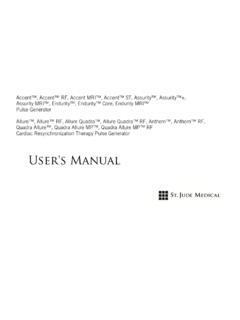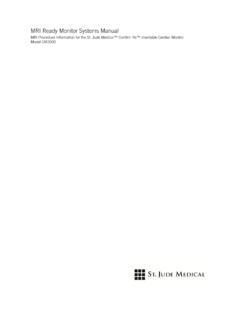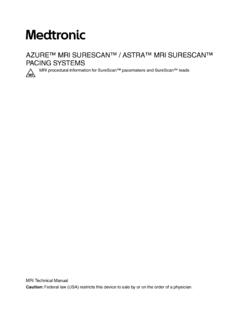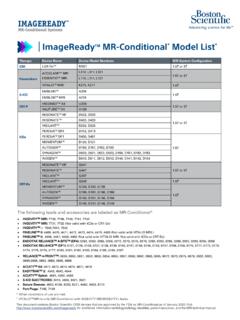Transcription of MRI Procedure Information - SJM
1 MRI Procedure Information For St. Jude Medical MR conditional Neurostimulation Systems Clinician's Manual Unless otherwise noted, indicates that the name is a trademark of, or licensed to, St. Jude Medical or one of its subsidiaries. ST. JUDE MEDICAL and the nine-squares symbol are trademarks and service marks of St. Jude Medical, Inc. and its related companies. Pat. 2016 St. Jude Medical, Inc. All Rights Reserved. Contents Introduction .. 1 Symbols and Definitions .. 1 Models and Implant Locations for MR conditional Neurostimulation Systems .. 2 MRI Equipment and Scanning Requirements .. 3 Warnings and Precautions .. 5 Warnings .. 5 Precautions .. 5 Potential Adverse Events .. 6 Preparing a Patient for an MRI Scan .. 6 Step 1: Confirm the Implanted System Contains Only MR conditional Components .. 6 Step 2: Confirm No Adverse Conditions to Scanning Are Present.
2 6 Step 3: Ensure the Neurostimulation System Is in MRI Mode .. 6 Step 4: Select the MRI Parameters According to the Scanning Requirements .. 12 Performing the Scan and Monitoring the Patient .. 12 Disabling the MRI Mode .. 13 Using a Patient Controller to Disable MRI Mode .. 13 Using a Patient Programmer to Disable MRI Mode .. 13 Troubleshooting .. 14 Troubleshooting Using a Patient Controller .. 14 Troubleshooting Using a Patient Programmer .. 15 Technical Support .. 16 Appendix A: Patient Eligibility Form for MRI Scans .. 17 i Introduction Read the Information in this manual before conducting an MRI scan on a patient with an implanted St. Jude Medical neurostimulation system. This manual contains Information about the components that comprise the MR conditional system, applicable warnings and precautions related to the MR conditional system, and the requirements that you must follow in order for the implanted neurostimulation system to be conditionally safe for MRI scans.
3 Refer to the appropriate clinician s manual or user s guide for non-MRI related Information . If you have any questions, contact Technical Support. See "Technical Support" (page 16). NOTE: Before conducting an MRI scan, always ensure that you are using the most recent version of these MRI procedures. Contact Technical Support or get the most recent version online at For more Information about MR conditional products, visit the St. Jude Medical product Information page at Symbols and Definitions The following symbols may be used in this document and on some of the products and packaging: Table 1. Symbols and definitions Symbol Definition Caution, consult accompanying documents magnetic resonance (MR) conditional , an item with demonstrated safety in the MR environment within the defined conditions. At a minimum, address the conditions of the static magnetic field, the switched gradient magnetic field, and the radiofrequency fields.
4 Additional conditions, including specific configurations of the item, may be required. magnetic resonance (MR) Unsafe, an item poses unacceptable risks to the patient, medical staff, or other persons within an MR environment 1 Models and Implant Locations for MR conditional Neurostimulation Systems The following table lists the approved model numbers and implant locations of the components that can comprise an implanted MR conditional neurostimulation system. The following figure shows the approved locations of an MR conditional implantable pulse generator (IPG) and lead (or leads). WARNING: For an MR conditional system, all implanted components must be approved MR conditional models and implanted in approved locations according to the following table. If the implanted system contains any other components or models, then the system is considered untested for an MRI environment.
5 In addition, a component must be implanted according to its approved location or the entire implanted system is considered untested. Table 2. Approved models and implant locations for an MR conditional neurostimulation system Component Model Location of Implanted Component IPG 3660 Proclaim 5 Elite IPG 3662 Proclaim 7 Elite IPG 3771 Prot g MRI IPG 3772 Prodigy MRI IPG Upper buttock, low back, midline, flank, or abdomen Lead* 3186 Octrode 60-cm lead 3228 Penta 60-cm lead Lead tip in the epidural space between the T7 and T12 vertebrae Lead anchor All St. Jude Medical models All locations * Multiple MR conditional lead models may be implanted. Figure 1. Approved locations for implanted components 1. Implant locations for the MR conditional IPG are the upper buttock, low back, midline, flank, and abdomen. 2. Implant locations for the tips of the MR conditional leads are in the epidural space between the T7 and T12 vertebrae.
6 2 MRI Equipment and Scanning Requirements Patients implanted with MR conditional components of a St. Jude Medical neurostimulation system must be scanned using a system according to the following requirements: CAUTION: Before reviewing the following requirements, use the Information in the previous table and figure to confirm the presence of only MR conditional neurostimulation components at approved implant locations. Then use this Information to review the following requirements carefully because different device-lead combinations have different scanning restrictions. NOTE: For Information about the MRI equipment that will be used to scan the patient, including important safety Information , equipment features, and instructions for use, refer to the manual for the MRI equipment. Table 3. RF field requirements (see Table 4 for additional scanning requirements) IPG Model Lead Model Scan Region RF Coil RF Power (SAR) Notes and Warnings Proclaim Elite 3660 3662 Octrode 3186 Any body part Body RF transmit coil with any receive-only coil (quadrature only) Whole body SAR W/kg WARNING: Personnel knowledgeable in MR safety should be involved to optimally plan the scan and actively monitor specific absorption rate (SAR) levels during the scan.
7 Ensure the scanner displays SAR prospectively. Exceeding these SAR limits could increase the risk of excessive heating of implanted components. NOTE: To allow the MRI scanner to estimate the SAR, ensure that you enter the patient s body weight accurately into the scanner. WARNING: Before an MRI scan, determine the patient's body temperature. If the patient has a fever, you should not perform an MRI scan. Head scans RF transmit-receive head coil (quadrature only) Normal operating mode WARNING: To avoid excessive heating that could cause serious patient injury, do not place any part of the RF transmit-receive coil over any implanted neurostimulation system component. WARNING: Only quadrature, birdcage RF transmit-receive coil designs have been tested. Do not use other transmit coils designs ( , linear, phased-ar ray, or saddle) because these have not been tested and could result in serious patient injury.
8 WARNING: Scans of the hips and shoulders are excluded and have not been tested using RF transmit-receive coils. WARNING: Before an MRI scan, determine the patient's body temperature. If the patient has a fever, you should not perform an MRI scan. WARNING: Do not conduct MRI scans in first-level controlled or second-level controlled operating mode. These modes allow higher levels of RF energy and may cause excessive heating of implanted components, which could result in serious patient injury. NOTE: The SAR requirements will be met if the scanner is in normal operating mode. Extremity scans Lower extremities: all except hip Upper extremities: all except shoulder RF transmit-receive extremity coil (quadrature only) Normal operating mode 3 Table 3. RF field requirements (see Table 4 for additional scanning requirements) IPG Model Lead Model Scan Region RF Coil RF Power (SAR) Notes and Warnings Proclaim Elite 3660 3662 Penta 3228 Any body part Body RF transmit coil with any receive-only coil (quadrature only) Whole body SAR W/kg WARNING: Personnel knowledgeable in MR safety should be involved to optimally plan the scan and actively monitor SAR levels during the scan.
9 Ensure the scanner displays SAR prospectively. Exceeding these SAR limits could increase the risk of excessive heating of implanted components. NOTE: To allow the MRI scanner to estimate the SAR, ensure that you enter the patient s body weight accurately into the scanner. WARNING: Before an MRI scan, determine the patient's body temperature. If the patient has a fever, you should not perform an MRI scan. Head scans RF transmit-receive head coil (quadrature only) Normal operating mode WARNING: To avoid excessive heating that could cause serious patient injury, do not place any part of the RF transmit-receive coil over any implanted neurostimulation system component. WARNING: Only quadrature, birdcage RF transmit-receive coil designs have been tested. Do not use other transmit coils designs ( , linear, phased-array, or saddle) because these have not been tested and could result in serious patient injury.
10 WARNING: Scans of the hips and shoulders are excluded and have not been tested using RF transmit-receive coils. WARNING: Before an MRI scan, determine the patient's body temperature. If the patient has a fever, you should not perform an MRI scan. WARNING: Do not conduct MRI scans in first-level controlled or second-level controlled operating mode. These modes allow higher levels of RF energy and may cause excessive heating of implanted components, which could result in serious patient injury. NOTE: The SAR requirements will be met if the scanner is in normal operating mode. Extremity scans Lower extremities: all except hip Upper extremities: all except shoulder RF transmit-receive extremity coil (quadrature only) Normal operating mode Prot g MRI 3771 -or - Prodigy MRI 3772 Octrode 3186 -or - Penta 3228 Head scans RF transmit-receive head coil (quadrature only) Normal operating mode WARNING: To avoid excessive heating that could cause serious patient injury, do not use the body RF transmit coil.
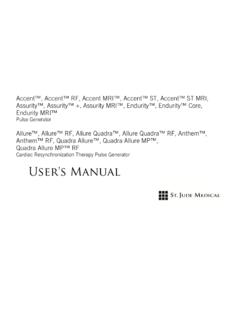



![Tendril STS 2088 [OUS] - St. Jude Medical Instructions for ...](/cache/preview/0/1/6/5/9/9/f/b/thumb-016599fbc524e50a7f361018615dac17.jpg)

